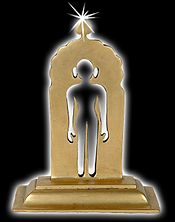- Nirvana (Jainism)
-
Jainism
This article is part of a series on JainismPrayers and Vows Ṇamōkāra mantra · Ahimsa · Brahmacharya · Satya · Nirvana · Asteya · Aparigraha · Anekantavada · Parasparopagraho Jīvānām Key concepts Kevalajñāna · Cosmology · Samsara · Karma · Dharma · Moksha · Gunasthana · Navatattva Major figures The 24 Tirthankaras · Rishabha · Mahavira · Acharya · Ganadhara · Siddhasena Divakara · Haribhadra Jainism by region India · Europe · United States · Canada Sects Śvētāmbara · Digambara · Svetambar Terapanth · Sthānakavāsī · Bhattaraka · Murtipujaka Texts Kalpa Sūtra · Āgama · Tattvartha Sutra · Sanmatti Prakaran Other Festivals Paryushana · Diwali
Jainism Portal
Nirvāṇa (Sanskrit: निर्वाण; Prakrit: णिव्वाण Nivvāṇa) in Jainism means final release from the karmic bondage. When an enlightened human, such as an Arihant or a Tirthankara extinguishes his remaining aghatiya karmas and thus ends his worldly existence, it is called nirvāṇa. Technically, the death of an Arihant is called nirvāṇa of the arihant, as he has ended his worldly existence and attained liberation. Moksa, that is to say, liberation follows nirvāṇa. An Arihant becomes a siddha, the liberated one, after attaining nirvana. However, the word nirvāṇa is often used to mean moksa, as well. Hence nirvāṇa means:
- Death of an Arihant, who becomes liberated thereafter, and
- Moksa
Contents
Description of Nirvāṇa of a Tirthankara in Jain Texts
Kalpasutra gives an elaborate account of Mahavira’s nirvāṇa. [1]
“ The aghatiya Karma’s of venerable Ascetic Mahavira got exhausted, when in this Avasarpini era the greater part of the Duhshamasushama period had elapsed and only three years and eight and a half months were left. Mahavira had recited the fifty-five lectures which detail the results of Karma, and the thirty-six unasked questions (the Uttaradhyana Sutra). The moon was in conjunction with the asterism Svati, at the time of early morning, in the town of Papa, and in king Hastipala's office of the writers, (Mahivira) single and alone, sitting in the Samparyahka posture, left his body and attained nirvana, freed from all pains.” (147) In the fourth month of that rainy season, in the seventh fortnight, in the dark (fortnight) of Karttika, on its fifteenth day, in the last night, in the town of Papa, in king Hastipala's office of the writers, the Venerable Ascetic Mahavira died, went off, cut asunder the ties of birth, old age, and death; became a Siddha, a Buddha, a Mukta, a maker of the end (to all misery), finally liberated, freed from all pains. (123)
That night in which the Venerable Ascetic Mahavira died, freed from all pains, was lighted up by many descending and ascending gods. (125)
In that night in which the Venerable Ascetic Mahavira, died, freed from all pains, the eighteen confederate kings of Kasi and Kosala, the nine Mallakis and nine Licchavis, on the day of new moon, instituted an illuminations on the Poshadha, which was a fasting day; for they said: 'Since the light of intelligence is gone, let us make an illumination of material matter!'(128)
” Nirvāṇa as Moksa
The terms moksa and nirvana are often used interchangeably in the Jain texts.[2][3]
Uttaradhyana Sutra provides an account of Gautama explaining the meaning of nirvāṇa to Kesi a disciple of Parsva. [4]
“ There is a safe place in view of all, but difficult of approach, where there is no old age nor death, no pain nor disease. It is what is called Nirvâna, or freedom from pain, or perfection, which is in view of all; it is the safe, happy, and quiet place which the great sages reach. That is the eternal place, in view of all, but difficult of approach. Those sages who reach it are free from sorrows, they have put an end to the stream of existence. (81-4) ” See also
References
- ^ Jacobi, Hermann; Ed. F. Max Müller (1884). Kalpa Sutra, Jain Sutras Part I, Sacred Books of the East, Vol. 22. Oxford: The Clarendon Press. http://www.sacred-texts.com/jai/sbe22/index.htm.
- ^ Jaini, Padmanabh (2000). Collected Papers on Jaina Studies. Delhi: Motilal Banarsidass Publ.. ISBN 81-208-1691-9.: "Moksa and Nirvana are synonymous in Jainism". p.168
- ^ Michael Carrithers, Caroline Humphrey (1991) The Assembly of listeners: Jains in society Cambridge University Press. ISBN-0521365058: "Nirvana: A synonym for liberation, release, moksa." p.297
- ^ Jacobi, Hermann; Ed. F. Max Müller (1895). Uttaradhyayana Sutra, Jain Sutras Part II, Sacred Books of the East, Vol. 45. Oxford: The Clarendon Press. http://www.sacred-texts.com/jai/sbe45/index.htm.
Categories:- Jain philosophical concepts
Wikimedia Foundation. 2010.


